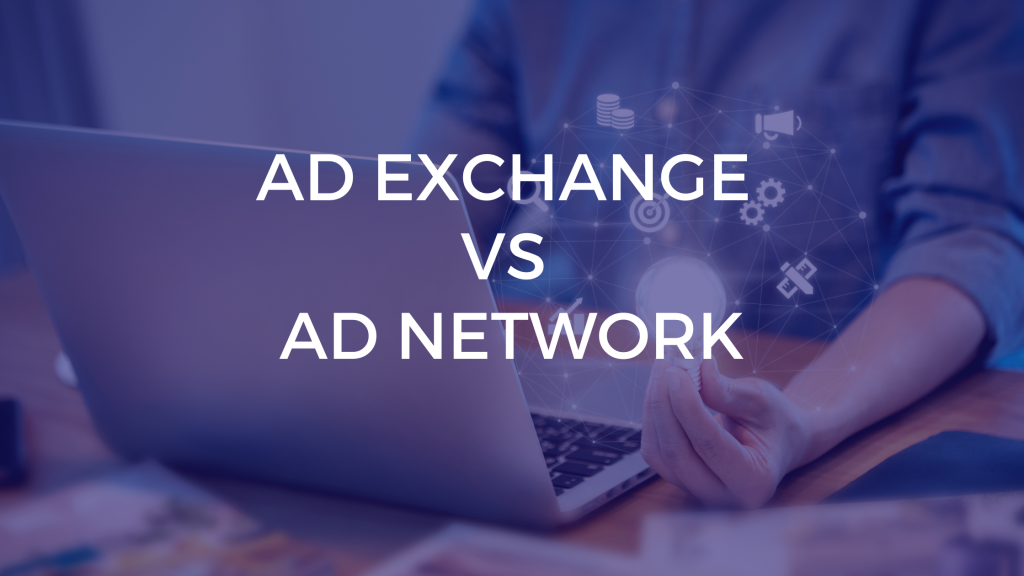Ad networks and ad exchanges serve similar functions. In general, they both collect free inventory from publishers in one location and sell it to advertisers. Both can be incorporated with demand and supply-side networks, allowing for programmatic ad buying and selling.
As a result, it’s difficult to distinguish between certain technology platforms, particularly if you depend on your DSP, who has little to no idea how it buys inventory and where it comes from. The sooner you decode those principles, the greater your chances of quickly optimizing your company and improving your brand.
In this article, we’ll look at ad networks vs ad exchanges, by highlighting their main differences, and what role they play in ad monetization.

What is an Ad Network?
The general definition of an ad network is a media company-aggregator that acquires inventory from various publishers and sells it to advertisers or agencies. It is primarily the display, smartphone, and video inventory.
When media purchasing became too difficult in the early 2000s, an advertisement network simplified the market by acting as an intermediary between the buying and selling sides.
What is an Ad Exchange?
By definition, an advertising exchange is a digital platform supply and demand parties (including publishers, advertisers, ad networks, DSPs, etc.) buy and sell inventory directly, without involving an intermediary. In most cases, ad exchanges run auctions and offer inventory to the highest bidder on an impression-by-impression basis, using real-time bidding technology.
To summarize, this type of marketplace arose in response to publishers’ need to sell their excess inventory.
How Does It Function?
Ad Network: Ad networks are usually companies that aggregate and curate publishers’ ad inventories, market them to advertisers, and charge a fee. Ad networks do the heavy lifting for publishers by categorizing ad inventories based on demographics, behavioral traits, or background. Ad inventories are purchased and sold in large quantities.
Ad Exchange: In the technical context, an ad exchange is a platform that allows advertisers, agencies, demand-side platforms (DSP), publishers, and supply-side platforms (SSP) to engage in the transaction. Since ad impressions are sold in real-time via a software program, the media buying process is highly transparent.
Transparency
Ad networks appeared in the digital advertising industry to make the media purchasing process more manageable, but they did not provide much clarification. Publishers have no idea who buys their inventory, and advertisers have no idea where their advertisement will appear.
In the case of ad exchanges, all parties involved have access to the details. Furthermore, since the programmatic exchange operates automatically through RTB technology, it provides transparency in terms of how and what specifics of the transaction are provided.
Inventory
Advertisers can receive more premium placements by partnering with an ad network, which comes with a premium charge but also guarantees the acquisition of exclusive inventories. This is particularly true for premium ad networks. There are also network topics (which are based on particular verticals) and inventory-specific networks such as mobile, video, and others.
An ad exchange network may also have a specific inventory — for example, there may be a display, video, or mobile ad exchange on the market. Although publishers do not obtain the best price for inventory sold via an ad exchange, they may still sell the remaining advertising placements to maximize their revenue.
Pricing
Inventory pricing within an advertising network is calculated by the ad network and it’s based on inventory value estimates. The price is set and cannot be adjusted.
When it comes to ad exchanges, the price of inventory fluctuates based on bids produced by the sell side through RTB auction. Similar to a traditional auction, the bid is won by the advertiser who offers the highest price for ad placement.
Ad network vs Ad exchange – In conclusion
Ad exchanges operate in a completely different manner than ad networks in terms of selling publisher inventory. Via:
- Selling each impression individually in real-time;
- Encouraging direct competition between advertisers;
- Providing both advertisers and publishers greater levels of transparency;
- Reducing administrative friction associated with selling and delivering ads, ad exchanges drive advertisers to pay higher CPMs and leave publishers with a greater percentage of ad spend.;
For publishers, this represents a huge opportunity. That is not to suggest that publishers should abandon ad networks entirely. Ad networks continue to act as a middleman between buyers and sellers. They actually buy a lot of inventory on ad exchanges. As a result, when publishers use ad exchange, they communicate with far more ad networks than they would if they had a direct relationship. CPMs rise as a result of the rivalry. Furthermore, the floor pricing mechanism offered by ad exchanges means that publishers can make their inventory accessible to the Market, but the Market can only serve it if it can outbid the publisher’s fallback ad.

